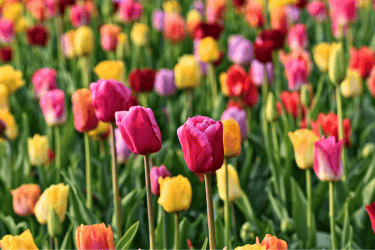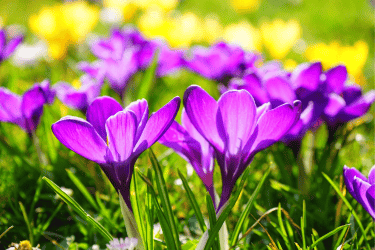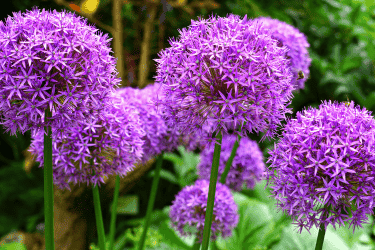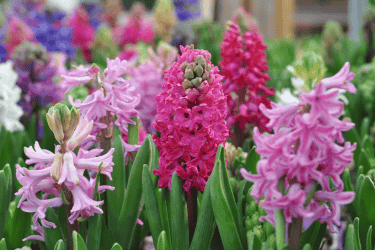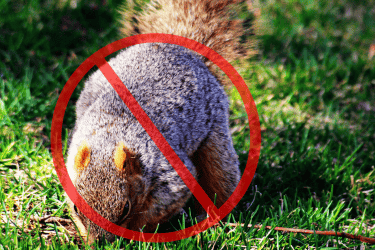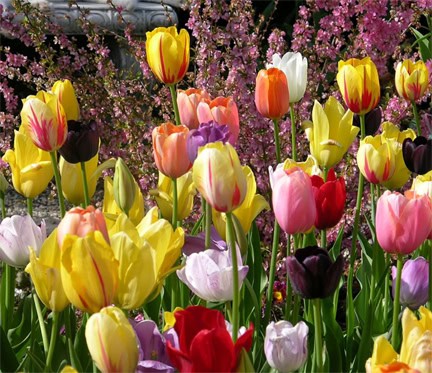
Fall Bulb Planting Guide
As the heat of summer gradually gives way to the crisp coolness of autumn, gardeners and nature enthusiasts alike find themselves drawn to the enchanting world of fall bulbs. These dormant beauties have the power to transform your garden into a breathtaking tapestry of colours, shapes, and fragrances. In this guide, we’ll delve into the captivating realm of fall bulbs, exploring when and how to plant them and suggesting a variety of bulbs to consider for a stunning seasonal display.
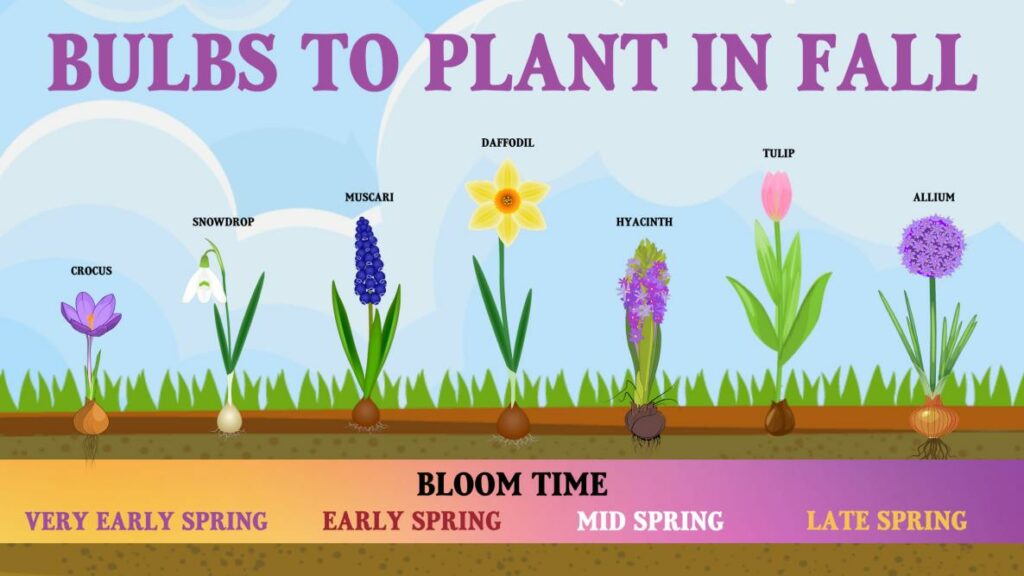
When to Plant Fall Bulbs:
Fall bulbs are unique in that they’re planted well in advance of their blooming season, allowing them time to establish roots before the ground freezes. The ideal time to plant fall bulbs typically ranges from late summer to early autumn, depending on your climate zone. As a general guideline:
- Early Fall (Late August to Early September): If you reside in a colder climate, it’s advisable to start planting your bulbs early. This ensures they have enough time to develop strong root systems before the onset of frost.
- Mid-Fall (Mid to Late September): For regions with milder autumn temperatures, mid-fall is an excellent time to plant fall bulbs. The soil is still warm enough to facilitate root growth, while the risk of early frost is relatively low.
- Late Fall (October): In warmer climates, where frost arrives later, you might be able to plant fall bulbs as late as October. However, be mindful that the later you plant, the less time the bulbs have to establish themselves before winter.
Check the Label for Bloom Time:
When selecting bulbs, it’s important to check the label to determine when they will bloom. Bulbs are typically categorized into early spring, mid-spring, or late spring bloomers. By understanding the bloom time, you can plan a continuous display of colour throughout the spring season. Early bloomers like crocuses and snowdrops herald the arrival of spring, while mid-spring varieties such as tulips and daffodils add vibrant splashes of colour. Late bloomers like alliums and late-season tulips extend the season, ensuring your garden remains a showstopper well into the warmer months.
How to Plant Fall Bulbs:
Planting fall bulbs requires some care and attention to detail to ensure they thrive and create a breathtaking display in the following spring. Here’s a step-by-step guide to get you started:
- Choose the Right Location: Most fall bulbs thrive in well-draining soil and prefer locations with ample sunlight. Select a spot that receives at least 6 hours of sunlight daily.
- Prepare the Soil: Work the soil to a depth of 8-10 inches, incorporating compost or well-rotted organic matter to improve drainage and fertility.
- Planting Depth: As a general rule, plant bulbs at a depth that’s about two to three times their height. Larger bulbs should be planted deeper than smaller ones.
- Spacing: Space bulbs according to the guidelines on the packaging, typically a few inches apart. This prevents overcrowding and allows each bulb sufficient space to grow.
- Proper Orientation: Place the bulbs with their pointed ends facing up and their flatter basal ends facing down.
- Cover and Mulch: Gently cover the bulbs with soil, patting it down to eliminate air pockets. Apply a layer of mulch to insulate the soil and help regulate temperature fluctuations.
- Watering: Water the area thoroughly after planting to help settle the soil and encourage root establishment.
Chart Source: www.almanac.com/planting-fall-bulbs-spring-flowers
There are many types and species of fall bulbs. There are different colours, heights and flowering times. So the first question to ask yourself is, what colour do you prefer? When do you want the flowers to be blooming? Where do you want the flowers to go – are they at the front of a garden or behind other plants? Is there a particular flower shape that appeals to you? All of these considerations will help you create the look you want using fall bulbs.
Bulbs to Consider for Your Fall Garden:
When venturing into the realm of fall bulbs, one is greeted by a captivating array of types and species, each with its own unique charm. From the regal Tulips to the cheerful Daffodils/Narcissus, the delicate Crocus that ushers in the spring, the striking Allium, and the fragrant Hyacinths, the world of fall bulbs is a tapestry woven with botanical marvels. And that’s just the beginning, as there are also lesser-known yet equally enchanting varieties like the ethereal Scilla (bluebells), the dainty Leucojum (summer snowflake), the captivating Eremurus (foxtail lily), the graceful Anemone, the charming Muscari (grape hyacinth), and the exquisite Fritillari, among others.

Chart Source: www.florissa.com
Each of these floral wonders boasts its own palette of colours, a unique timing of blooms, and a distinct stature in terms of height. Thus, before embarking on your planting journey, the wisdom of planning your design becomes an invaluable tool. With a thoughtfully crafted blueprint, you can ensure that the symphony of colours, the choreography of bloom times, and the harmonious play of heights unite to create a garden that’s not only visually breathtaking but also a testament to the wonders of nature’s artistry.
Tulips
Within the Tulipa genus, there are many varieties, colours (ranging from white to pink, yellow and even blue), heights and even flowering times. The most common tulips for mass plantings normally are Triumph, Darwin Hybrid, Single Early and Landscape types. The other types of Tulips (Doubles, Botanical, Kaufmanniana, Parrot, etc.) are usually novelty or special interest types.
Tulips: Flowering Times and Heights
| Mid-Spring Flowering(April – May) | Height cm (“) | Late-Spring Flowering(May) | Height cm (“) |
| Landscape | 50-70 (20″- 28″) | Lily Flowering | 40-60 (16″-22″) |
| Single Early | 30-50 (12″-20″) | Single Late | 50-70 (20″-28″) |
| Double Early | 25-30 (10″-12″) | Giant Single Late | 70-75 (28″-30″) |
| Triumph | 20-60 (8″-22″) | Double Peony | 45-60 (16″-24″) |
| Botanical | 10-25 (4″-10″) | Parrot | 35-70 (14″-28″) |
| Kaufmanniana | 20-25 (8″-10″) | Darwin Hybrid | 45-70 (18″-28″) |
| Greigii | 20-50 (8″-20″) | Fringed | 45-70 (18″-28″) |
| Multiflowering | 35-50 (12″-20″) | ||
| Fosteriana | 35-45 (14″-18″) |
Daffodils and Narcissus
Daffodils and narcissus are a bright, cheerful welcome of warmer weather. They come in hues of yellow, white and even pink. These types usually flower at about the same time, typically in mid-spring (April-May). The difference between the types is height and colour combinations.
Daffodil/Narcissus: Heights
| Type of Daffodil/Narcissus | Height cm (“) |
| Trumpet | 35-50 (14″-20″) |
| Double | 35-40 (14″-16″) |
| Cupped | 35-45 (14″-18″) |
| Split Corona | 35-50 (14″-20″) |
| Poetaz | 35-40 (14″-16″) |
| Rock Garden | 20-40 (8″-16″) |
| Dwarf | 15-25 (6″-10″) |
| Miniature | 10-25 (4″-10″) |
| Novelty | 40-45 (16″-18″) |
Spring Flowering Crocus
Spring flowering crocus is always one of the first signs of spring as they mostly flower in early spring, sometimes even through the snow. Spring flowering crocus/snow crocus come in colours from white to purple, yellow and mixtures of those. They are fairly small in size, not normally reaching more than 4″ tall. They are also great for naturalizing, which means spreading or multiplying on their own. They are quite stunning when they are planted in a lawn area.
Alliums
Most Allium flower later on, in the summer months, making it a great way to extend the season of colour. They vary in size from 10-120 centimetres tall (4″-48″) and can have very large flowering heads. They range in colour from white to purple, even blue. Alliums are great at the back of the garden for the taller types, planting in containers and being used for cut flowers.
Hyacinth
Hyacinths flower in the mid-spring, which is April-May. They are normally about the same height, around 25 centimetres tall (10″). Hyacinths also come in a variety of colours ranging from white, purple and pink and even apricot hues. Hyacinths are also very fragrant, making them a great cut flower and are very effective for forcing indoors.
How To Keep the Squirrels & Pests From Feasting on Your Bulbs
As you embark on your journey to cultivating a mesmerizing garden adorned with fall bulbs, it’s essential to anticipate the presence of squirrels and other garden pests that may see your bulbs as a tempting feast. To ensure your botanical treasures remain undisturbed, consider these effective strategies to fortify your garden against these determined intruders:
Choose Unappetizing Bulbs:
Opt for bulbs that are less appealing to squirrels and pests. Daffodils (Narcissus) and Alliums are known for their unpalatable taste, deterring many critters from feasting on them. While no bulb is entirely immune, starting with these less attractive options can help.
Other bulbs generally avoided by critters:
- Daffodils (Narcissus)
- Allium
- Snowdrops
- Fritillaria
- Scilla
- Muscari
- Crocus
- Hyacinths
- Anemone
- Camassia
Use Physical Barriers:
Employ protective barriers to shield your bulbs. Placing wire mesh, hardware cloth, or chicken wire over the planting area can create a barrier that prevents squirrels and pests from accessing your bulbs while still allowing them to grow through.
Utilize Repellents:
Scent-based repellents can deter pests from approaching your bulbs. Sprinkling crushed red pepper, garlic powder, or commercial animal repellents, like Blood Meal or Bone Meal, around the planting area can create a smell that squirrels and other animals find unpleasant.
Plant in Layers:
Plant your bulbs in layers by adding a layer of bulbs and then covering them with soil before adding the next layer. This makes it more challenging for pests to detect and reach the bulbs, reducing the chances of them being disturbed.
Try Companion Planting:
Introduce companion plants that naturally repel pests. For instance, planting daffodils alongside garlic or onions can discourage squirrels and other animals from digging near the bulbs.
Mulch Strategically:
Apply a layer of mulch over the planting area to deter squirrels from digging. Opt for materials like gravel, crushed shells, or coarse bark that can be uncomfortable for them to dig through.
Regular Maintenance:
Keep your garden tidy and remove fallen leaves and debris regularly. Squirrels often dig in loose soil looking for food, so maintaining a clean garden can discourage their presence.
Observation and Adaptation:
Regularly monitor your garden to identify signs of pest activity. If you notice digging or disturbances, adjust your protective measures accordingly.
By implementing a combination of these strategies, you can significantly reduce the risk of squirrels and pests wreaking havoc on your fall bulbs. With determination and a bit of ingenuity, you’ll be well on your way to enjoying a garden that flourishes with the beauty and grace of your carefully planted fall bulbs.
How to Plan an Aesthetically Pleasing Spring Bulb Garden
As the chill of fall starts to set in, it’s the perfect time to plan for the vibrant burst of colour that spring brings. One of the most rewarding ways to create a show-stopping garden in early spring is by planting bulbs now. While bulbs like tulips and daffodils are beloved classics, combining different bulb varieties, colours, and bloom periods will make your garden more visually dynamic and exciting all season long. Here’s how you can plan a stunning bulb garden that blooms from early to late spring with a harmonious mix of colours and bloom types.
Why Bulb Gardens?
Spring-flowering bulbs are among the most low-maintenance plants. Once tucked into the soil in the fall, they need little care over winter and will reward you with vibrant blooms when spring arrives. The key to a spectacular bulb garden is planning for continuous bloom time, colour harmony, and variety in flower shapes and sizes.
1. Early Spring Elegance: Snowdrops and Crocuses
- Featured Bulbs: Snowdrops (Galanthus nivalis), Crocus (Crocus vernus)
- Colour Palette: White, purple, yellow
- Bloom Time: Early spring (late February to March)
For an early burst of colour, plant snowdrops and crocuses together. Snowdrops, with their delicate white bell-shaped flowers, will start emerging as soon as the snow melts. Pair them with colourful crocuses in purple, yellow, and white for a cheerful, bright patch of early blooms. Plant these bulbs around pathways, under trees, or in clusters along garden edges to create a charming spring awakening.
2. Mid-Spring Pastel Charm: Daffodils and Hyacinths
- Featured Bulbs: Daffodils (Narcissus), Hyacinths (Hyacinthus)
- Colour Palette: Soft yellow, peach, light pink, lavender
- Bloom Time: Mid-spring (April)
A romantic pastel garden is easy to achieve with daffodils and hyacinths. Daffodils bring classic charm with their trumpet-shaped flowers, while hyacinths add a delightful fragrance and clusters of starry blooms. Choose varieties of daffodils in pale yellow, peach, or white, and pair them with pink or lavender hyacinths for a soft, dreamy display. This combination looks especially beautiful in beds close to windows or patios, where their sweet scent can be enjoyed.
3. Bold and Bright: Tulips and Grape Hyacinths
- Featured Bulbs: Tulips (Tulipa), Grape Hyacinths (Muscari armeniacum)
- Colour Palette: Red, orange, purple, blue
- Bloom Time: Mid to late spring (April to May)
For a bold, eye-catching display, tulips are your go-to. Plant them in groups, mixing colours like deep red, bright orange, and soft pink for a vibrant show. Complement the tulips with low-growing grape hyacinths, which add texture with their spiky clusters of deep blue blooms. This duo works well in structured garden beds or along pathways where the height of the tulips contrasts with the carpet-like spread of the grape hyacinths below.
4. Late Spring Drama: Alliums and Spanish Bluebells
- Featured Bulbs: Alliums (Allium giganteum), Spanish Bluebells (Hyacinthoides hispanica)
- Colour Palette: Deep purple, violet-blue, white
- Bloom Time: Late spring (May to early June)
As spring transitions to early summer, add a dramatic touch with alliums. Their large, globe-shaped purple blooms stand tall and create a striking architectural feature in the garden. Pair them with delicate, nodding Spanish bluebells for a woodland-inspired look. Their violet-blue flowers contrast beautifully with the strong form of the alliums, creating an enchanting late-spring border.
5. Naturalized Meadow Mix: Fritillarias and Dwarf Narcissus
- Featured Bulbs: Fritillaria (Fritillaria meleagris), Dwarf Narcissus (Narcissus ‘Tête-à-Tête’)
- Colour Palette: Deep purple, white, yellow
- Bloom Time: Mid to late spring (April to May)
For a naturalized meadow look, plant a combination of fritillarias and dwarf narcissus. Fritillarias, with their striking checkerboard pattern, add a touch of whimsy to any garden. These unique flowers look beautiful when scattered among clusters of dwarf narcissus, whose bright yellow blooms will pop against the fritillarias’ darker tones. This pairing works well in a more casual garden, especially around trees or in slightly shaded areas.
Tips for a Cohesive Design:
- Layer Your Bulbs: To maximize the use of space and create continuous blooms, plant bulbs in layers. For example, plant large bulbs like alliums deeper in the soil, with smaller bulbs like grape hyacinths on top. This way, as one set of blooms fades, the next will start to rise.
- Consider Bloom Time: Mix early, mid, and late spring bloomers to ensure your garden is full of life throughout the entire season. A little planning now will give you weeks of uninterrupted colour.
- Colour Harmony: While contrasting colours can make a bold statement, using a limited colour palette can create a more cohesive and elegant look. For example, sticking to pastels or shades of the same colour will give your garden a soft, serene feel.
- Vary Heights: For an aesthetically pleasing garden, choose bulbs that vary in height. Taller plants like alliums create a dramatic backdrop, while shorter bulbs like crocuses and grape hyacinths fill in the front.
Planning a spring bulb garden is a bit like creating a living painting—you get to choose the colours, shapes, and textures that best fit your garden’s personality. By carefully selecting a mix of early, mid, and late spring bloomers and layering colours and heights, you can enjoy a long-lasting and beautifully dynamic display throughout the spring months. So, get those bulbs in the ground this fall, and prepare for a dazzling show come spring!
